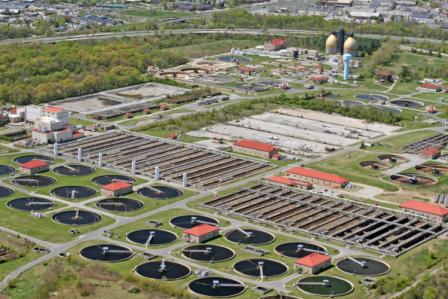National Study of Nutrient Removal and Secondary Technologies
 Back River Wastewater Treatment Plant, Baltimore. Photo by Jane Thomas, Integration and Application Network, University of Maryland Center for Environmental Science. ExitEPA is initiating a national study focused on nutrient removal at municipal wastewater treatment plants, also called publicly owned treatment works
Back River Wastewater Treatment Plant, Baltimore. Photo by Jane Thomas, Integration and Application Network, University of Maryland Center for Environmental Science. ExitEPA is initiating a national study focused on nutrient removal at municipal wastewater treatment plants, also called publicly owned treatment works![]() publicly owned treatment worksA waste-treatment works owned by a state, unit of local government, or a tribal entity, usually designed to treat domestic wastewaters. (POTWs).
publicly owned treatment worksA waste-treatment works owned by a state, unit of local government, or a tribal entity, usually designed to treat domestic wastewaters. (POTWs).
Updates (November 29, 2016):
- Facilities DO NOT need to respond to the draft questionnaire at this time. EPA will obtain approval under the Paperwork Reduction Act prior to asking facilities to respond.
- The comment period for the Federal Register closed on November 18, 2016.
Background
Nutrient pollution is one of America’s most widespread, costly and challenging environmental problems impacting water quality. Excessive nitrogen and phosphorus in our waters can lead to a variety of problems including eutrophication and harmful algal blooms, with impacts on drinking water, recreation and aquatic life. A wide range of human activities can contribute to nutrient pollution including stormwater runoff, agriculture, and wastewater discharges.
The treatment technologies utilized at POTWs are not always effective at removing nitrogen and phosphorus from wastewater before it is discharged into waterways, contributing to nutrient pollution. Many facilities have added treatment to improve nutrient removal, but these upgrades are not necessarily feasible for all POTWs. Other facilities have instead achieved better nutrient reduction through basic adjustments and optimization of facility operation and maintenance practices.
- Establish a statistically representative, nationwide baseline for nutrient discharge and removal at these facilities, and
- Characterize operation and management practices that result in improved nutrient reduction.
In order to identify the facilities that should be surveyed, EPA plans to collect basic information from all facilities nationwide through a questionnaire. The questionnaire is expected to be sent out to facilities in mid-2017.
Documents
- Federal Register Notice (September 19, 2016)
The comment period for the Federal Register notice has closed. Documents related to the notice, including the draft questionnaire, can now only be accessed through EPA’s docket at regulations.gov. The Docket Number is EPA-HQ-OW-2016-0404. EPA is currently addressing public comments and working with stakeholders to revise the draft questionnaire. The final version of the questionnaire is expected to be sent out to facilities for response in mid-2017. Facilities do not need to respond to the draft questionnaire at this time.
Webinars
EPA hosted webinars on November 2 and 10, 2016, to provide background on the study, and specifically to demonstrate the electronic format and content of the draft questionnaire. EPA is currently revising the draft questionnaire. To avoid confusion between draft versions of the questionnaire, recordings of the November 2 and 10 webinars will not be posted. Additional webinars will be offered in 2017 before the final version of the questionnaire is sent to facilities.
Additional Resources
- Clean Watersheds Needs Survey
- Improving Nutrient Reduction at Wastewater Treatment Plants - Case Studies
Additional Information
For more information on the study, please send inquiries to nutrient-removal-study@epa.gov.
